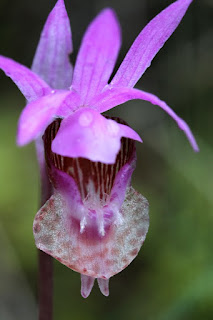And so we come to the end of another season of orchid hunting and to the last post of the year. There remain three species native to the state of Washington that we still have not seen, though all of them are rare to very rare here. They are Wister's Coralroot, Corallorhiza wisteriana, the Broad-lipped Twayblade, Listera convallarioides, for which we have a location, but missed it this past summer, and the natural hybrid, the Ute Ladies' Tresses, Spiranthes diluvialis. These are at the head of our list for next summer, and we do have a couple of locations for the Ute Ladies' Tresses, but both are outside of our own state.
It was good summer. We saw and photographed many familiar species in locations we had already visited and in new locations and we saw three new species, Cypripedium californicum, the California Lady's Slipper, and Goodyera repens, the Lesser Rattlesnake Orchis, neither of which are native to Washington, and Platanthera sparsiflora, the Few-flowered Rein Orchis.
Cypripedium californicum
Goodyera repens and Platanthera sparsiflora
We found one important variety that we had not seen before, Vreeland's Coralroot, Corallorhiza striata var. vreelandii (top photo), and several significant forms of common species, the white form of the Western Fairy Slipper, Calypso bulbosa var. occidentalis fma. nivea, the yellow-stemmed form of the Western Spotted Coralroot, Corallorhiza maculata var. occidentalis fma. aurea.
Corallorhiza maculata var. occidentalis fma. aurea
Calypso bulbosa var. occidentalis fma. nivea
We also found locations for the unspotted form of the Western Spotted Coralroot, Corallorhiza maculata var. occidentalis fma. immaculata and a Washington location for Chamisso's Orchid, Platanthera chorisiana, but both were nearly finished flowering and we were unable to get any really decent pictures. In all it was an excellent season and one to be remembered.

























































